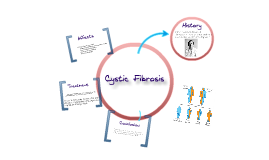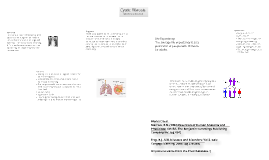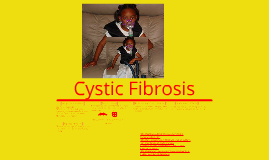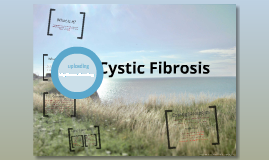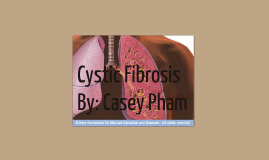Cystic Fibrosis
Transcript: Treatments There is no cure for cystic fibrosis, thus treatments are essential. Treatment Goals: preventing/controlling lung infections, loosening/removing mucus from the lungs, preventing/treating intestinal blockage, and providing adequate nutrition. Medications: antibiotics, mucus-thinning drugs, bronchodilators, and oral pancreatic enzymes. What is Cystic Fibrosis? Also known as, Mucoviscidosis of the pancreas It is a chronic disease that affects the lungs and digestive system. Overview: A defective gene/protein cause the body to produce abnormally thick, sticky mucus that clogs the lungs. It leads to life-threatening lung infections, obstructs the pancreas, and stops natural enzymes from helping digesting and absorb food. Cystic Fibrosis By: Casey Pham Tests Every state in the U.S. now routinely screens newborns for cystic fibrosis. Sweat Test: A sweat-producing chemical is applied to a small area of skin. The collected sweat is then tested to see if it's saltier than normal. Genetic Test: DNA samples from blood or saliva can be checked for specific defects on the gene responsible for cystic fibrosis. Causes The leading cause is a defect in a gene that changes a protein that regulates the movement of salt in and out of cells. The result in the respiratory, digestive, and reproductive systems are thick/sticky mucus and increased salt in sweat. Symptoms Digestive Symptoms: foul smelling, poor growth/weight gain in spite of a good appetite, and difficult bowel movements. Respiratory Symptoms: persistent coughing, wheezing or shortness of breath, a decreased ability to exercise, repeated lung infections. Common Infant Symptom: sweat abnormalities that can lead to heat stroke and salt depletion. Who does it affect? 30,000 children and adults Approximately 1,000 new cases each year The disease can be inherited in an autosomal recessive pattern. More than 10 million Americans are carriers of a faulty cystic fibrosis gene. A majority of those with these genes are unaware of it. More than 70% of patients are diagnosed by age two. The predicted median age of survival is in the late 30s. Cystic fibrosis is most common for: white Northern European ancestry, Hispanics, African-Americans, and some Native Americans. How have we advanced today? In the 1950s, few children with cystic fibrosis lived to attend elementary school. Today, research and medical treatment advancements have extended a vast number of children and adults. People with cystic fibrosis are now able to live into their 30s, 40s, and further. References: http://www.cff.org/AboutCF/ http://www.mayoclinic.com/health/cystic-fibrosis/DS00287 http://www.nhlbi.nih.gov/health/health-topics/topics/cf/ http://ghr.nlm.nih.gov/condition/cystic-fibrosis http://emedicine.medscape.com/article/1001602-overview#aw2aab6b2b5aa






